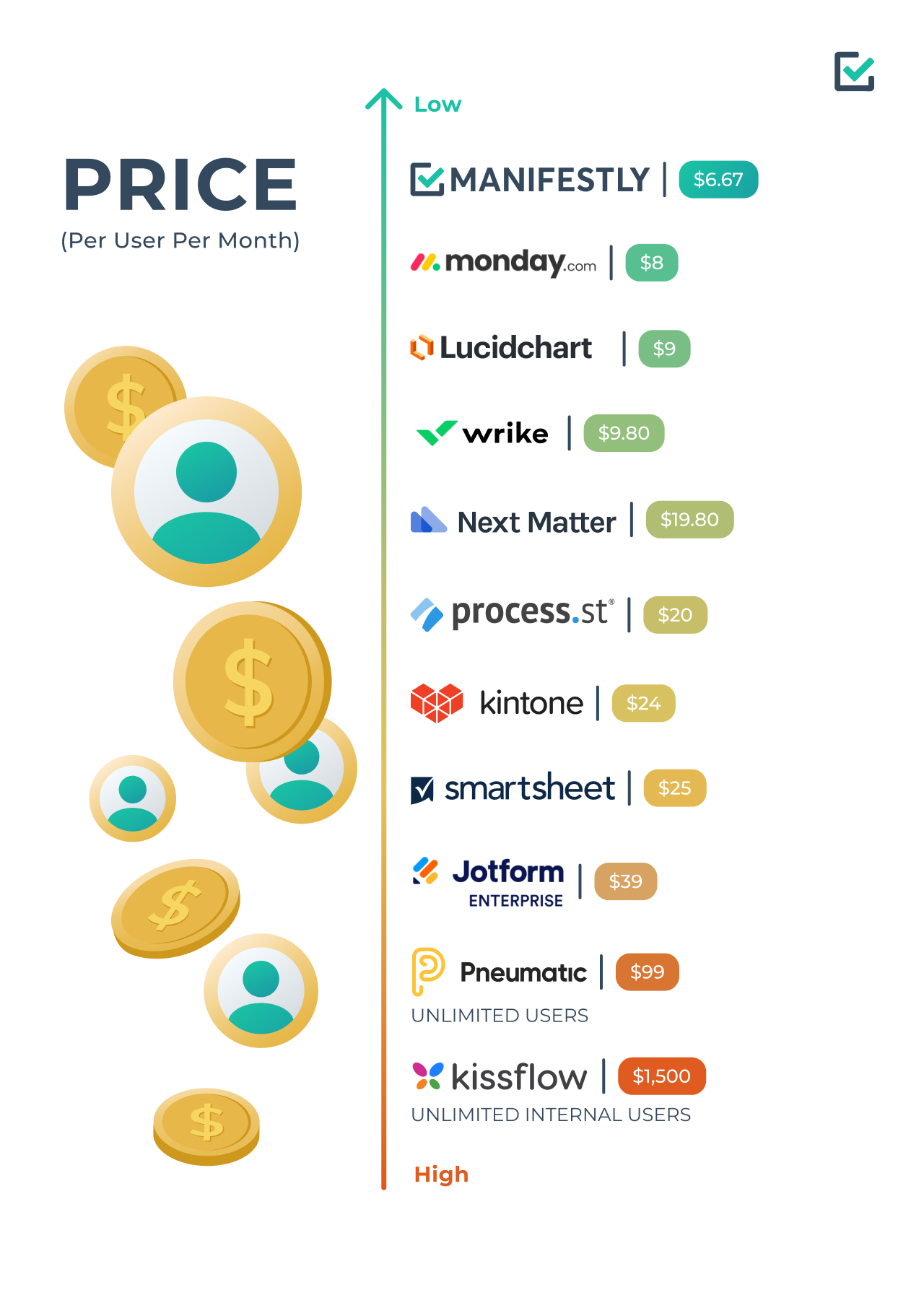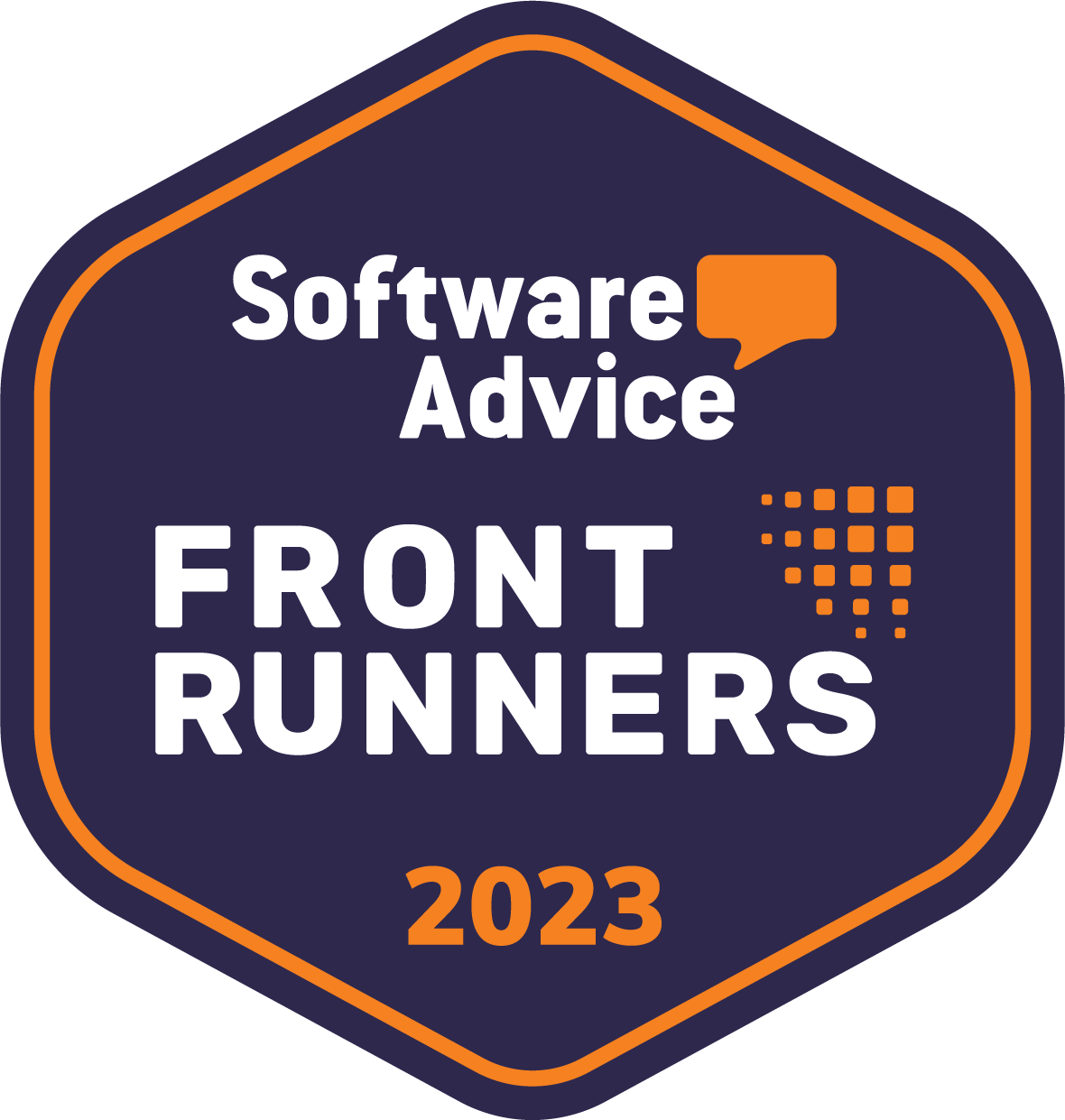
- Introduction
- What Should You Look for in Workflow Management Software?
- Honest Software Comparison:
- monday.com
- Kintone
- Pneumatic Workflow
- Wrike
- Next Matter
- Process Street
- Smartsheet
- Kissflow Workflow
- Lucidchart
- Jotform Enterprise
- Workflow Software FAQ
Workflow management software is the lynchpin of successful business processes, aiding in streamlining tasks, enhancing transparency, and fostering employee collaboration. Whether you’re a small business owner or an established enterprise manager, keeping a tight rein on your team’s workflow is integral to increased productivity.
In this article, we will review the top 10 workflow management software out there. We will compare their features, weaknesses, pricing, integrations, and automation capabilities, helping you choose the best solutions to fit your needs. Although we are a direct competitor of those workflow software tools, we’ll try to be as unbiased as possible. At the same time, we will try to use this comparison to show you the main features of Manifestly.
What Should You Look for in Workflow Management Software?
Workflow software should be simple, straightforward, and able to handle a steep change in volume or complexity. Key features to consider include:
* User-friendly interface: Layman, non-technical staff should intuitively understand and interact with the software.
* Scalability: The software should grow with your business needs.
* Integration: The ability to seamlessly connect and share data with other tools your team uses.
* Reporting and Analytics: Insightful data to analyze the effectiveness of your workflows.
* Automation: To automate repetitive, mundane tasks.
How to Choose a How Choose a Workflow Management Software
The perfect workflow management software aligns with your business needs. Whether you prioritize user-friendly interfaces, powerful integrations, or robust automation, options are plentiful. Before making your selection, consider your organization’s needs deeply and do thorough research to find your perfect match. Through this, you can ensure a smoother, more efficient workflow process that will drive your business operations to new heights.
We hope this comprehensive review and comparison will shine a light on the strengths and weaknesses of different workflow management tools and help you narrow down your choices. Remember, it’s not about finding the “best workflow software” on the market, but rather honing in on the most suitable one for your particular business needs.
Use this comparison as a guide, but don’t hesitate to try out different software through trials and demos. Use these trials as they are a perfect opportunity to see how such tools cater to your specific workflow strategy and organization.
Ultimately, a keen understanding of your business processes, coupled with the right workflow management software, can bring about transformational business growth and productivity. The time and effort invested in finding the right tool can be one of the most valuable investments you can make in your business journey.
Top 10 Workflow Management Software Comparison
1. Monday.com
Best known for its flexibility, Monday.com accommodates businesses of all sizes. Its key features – such as project planning, time tracking, workload management, multiple views, and reporting – foster excellent project workflow management. However, its limitations include limited mobile application functionality and a relatively high price tag. Still, it integrates well with tools like Slack, Jira, and GitHub and supports automation, allowing for repetitive task elimination.
Compared to Manifestly, Monday.com offers similar features but at a higher price. Both software solutions present a broad range of integrations and if you are currently using Monday but want to try a cheaper alternative, Manifestly might just be what you are looking for.
2. Kintone
Kintone stands out with its customizable features. The workflow management software platform allows companies to build, integrate, and use business process applications. A slight downside is that Kintone may require technical expertise to navigate the platform. It allows for integration with other services through APIs, hence improving your workflow process.
In contrast, Manifestly focuses on the user-friendly experience, even for non-tech-savvy users. While Kintone trumps in customization and integration scope, Manifestly provides the same 5 GB of file storage and 5 users plan just for $ 6.67/month. While Kintone pricing begins at $24 per user per month with a minimum of 5 users.
3. Pneumatic Workflow
Pneumatic offers a user-friendly interface for workflow automation. It features task management and the use of standard forms for various project workflows. A limitation may be the lack of a robust mobile application. While it does offer basic automation features, it is not as comprehensive when compared to Manifestly.
Pneumatic is best known on the market for its comprehensive pre-built workflow template library. However, a list of 306 templates from Manifestly covers almost all areas you could possibly need in your business.
4. Wrike
Wrike shines with its comprehensive reporting capabilities and strong project management features. A downside could be its steep learning curve for new users. Wrike incorporates with numerous third-party systems, including SalesForce and Adobe Creative Cloud, and provides excellent automation facilities.
When compared to Manifestly, Wrike might require more effort to handle for those unacquainted with such tools. It’s also limited to 10 workflows per space, when with Manifestly you can enjoy Unlimited Workflows & Workflow Runs.
5. Next Matter
Next Matter offers a no-code platform, which makes it user-friendly for businesses of all sizes. One limitation, though, is the lack of advanced reporting and analytics tools. It supports integrations with popular business tools and offers robust automation capabilities.
Although it lacks advanced reporting compared to Manifestly, Next Matter stands out for its no-code feature that provides ease of use. The pricing also bites a bit with $20/user/month and a minimum of 50 users.
6. Process Street
The best feature of Process Street is its checklist-based interface, and the capacity to build and automate workflows with ease. The limitations could be the absence of advanced project management tools. However, it does enable integrations with over 2000+ apps via Zapier and provides powerful automation features.
You can read a comprehensive comparison of Process Street and Manifestly here: https://www.manifest.ly/process-street-alternative
7. Smartsheet
Smartsheet offers a host of features such as project management, automation, and integrations. However, its interface might be a little more complex for new users. It provides integration with popular apps like Microsoft 365 and G Suite and supports automation functions.
While Smartsheet could be a good upgrade for those, who are using Google or Excel spreadsheets, it has a set limit to rows per spreadsheet and also a imited change-tracking functionality.
8. Kissflow Workflow
Kissflow shines in workflow automation and customization. However, the platform’s limitations include difficult migration from other tools and limited reporting and analytics. Despite this, Kissflow offers a wide range of third-party integrations, and, as a workflow automation software, provides advanced automation capabilities.
When compared with Manifestly, Kissflow offers the same functionality, but at a higher price.
9. Lucidchart
Lucidchart is known for its easy-to-use flowchart and diagram creation tools that aid workflow design and process automation. The limitation could be its lack of robust task management features. It does, however, integrate seamlessly with popular platforms and excels in workflow automation.
While both Manifestly and Lucidchart are user-friendly, Lucidchart falls short in comprehensive task management tools. It works better to visualize the workflow in a chart, while Manifestly is more result-oriented making sure you don’t miss anything with its checklists and comprehensive automation.
10. Jotform Enterprise
Best known for its scalable data collection tools, Jotform Enterprise allows users to create customizable workflow management systems. However, it may at times become too complex for users seeking a simple solution. Jotform’s integrations include popular tools such as Gmail and Dropbox, and it also supports automation capabilities.
Compared to Manifestly, Jotform Enterprise works better for larger B2B-oriented enterprises, while Manifestly caters to all types and sizes of businesses.

Conclusion for Workflow Management Software
In the vast landscape of workflow software, the road to choosing the right tool can be overwhelming. Each platform offers unique functionalities and advantages, all designed to enhance efficiency, productivity, and seamless collaboration within your team.
Remember, your business is unique, and hence requires a solution tailor-made for your specific needs. Be it the intuitive interfaces, extensive customization options, analytics depth, or automation capabilities, every tool we’ve reviewed brings a powerful proposition to the table.
So, how do you find the software that clicks perfectly with your workflow? There’s no better way than to experience it firsthand!
That’s why we recommend booking a free personalized 30-minute demo with Manifestly – witness how our platform revolutionizes your daily operations and brings order to the chaos of workflow management.
See in real time how, under the umbrella of Manifestly, you can track work progress, streamline processes, allocate resources efficiently, and much more – thus making project management a breeze.
CTA Section
FAQ
